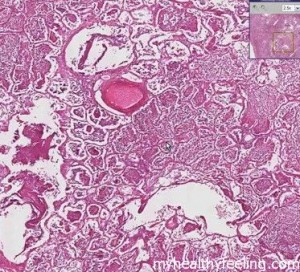What is legionella pneumonia? Also referred to as legionnaire’s disease, it is an infectious condition caused due to a bacteria know as legionella pneumophila. It is believed that such infectious bacteria are usually present in water delivery systems. Such bacteria can also dwell in moist and warm ventilation or air conditioning system. These bacteria are particularly found in huge buildings and hospitals where such air conditioning systems are common. It is reported that 1 to 8% of all Legionella pneumonia cases are caused due to such conditions.
This disease is contagious and is transferable from person to person if they come in contact to any contaminated sources. Such germ can contaminate the air and spread through it. This germ incubates within a period of 2 to 10 days after exposure. Lengionella infection is usually found amongst mid- aged people as well as older individuals. In several cases Legionella pneumonia is also diagnosed in children; however the condition may be comparatively benign in children than adults. There are certain risk factors linked with the growth of the disease such as renal malfunction or failure, smoking addiction, chronic obstructive pulmonary disease and diabetes.
There are other factors that may augment the risk of getting affected by Legionella pneumonia, which includes addiction to alcohol, aging, suppression of immune system through medications etc. Legionella pneumonia can be determined by symptoms such as muscles pain, muscles stiffness, dramatic reduction of energy, ache in joints, head pain and fever. The patient infected may experience chills and suffer from fever of around 105 degree Fahrenheit. Some of the severe conditions experienced are tremors, chest pain as well as blood coughs. Patients of Legionella pneumonia may also experience mental changes for example hallucination, confusion along with lethargy.
Ataxia and diarrhea may also be noticed in case a person is afflicted by Legionella pneumonia. He or she may cough without the prevalence of sputum while the infection is in its early stages but it may further maturate and blood containing sputum may be noticed in coughs.
To diagnose the condition there are several physical tests that are performed on the patient by the doctor. The doctor may use a device called stethoscope and try to hear a particular kind of sound which is called cackles. There are other tests that may be suggested for a legionella pneumonia patient which includes x-ray imaging of chest, liver function tests and complete blood count. Arterial blood gas and urine tests may also be necessary in some cases. Erythrocyte sedimentation rate or ESR accompanied with sputum direct fluorescent antibody test or just DFA are other two diagnoses which may help in detecting the prevalence of Legionella Pneumonia. It is a serious condition and should be treated immediately as it may also lead to adverse consequences such as lung failure and death.
Legionella Pneumonia treatment should be started as soon as the condition is detected. There are medicines from quinolones category which may be prescribed by your doctor as treatment. These quinolones includes levoflxacin, gatifloxacin etc. Drugs such as erythromycin and clarithromycin, which are Macrolides may also be suggested to the legionella pneumonia afflicted patients.

I HAVE BEEN TAKEN SILVER SOLUTION AND TURMERIC ALSO PROBIOTIC CAPSOLES AND STONE BREAKER FOR KIDNNEY AND GULBLADDER STONE DETOX HPOING THAT I WONT HAVE TO SEE A DOCTOR.